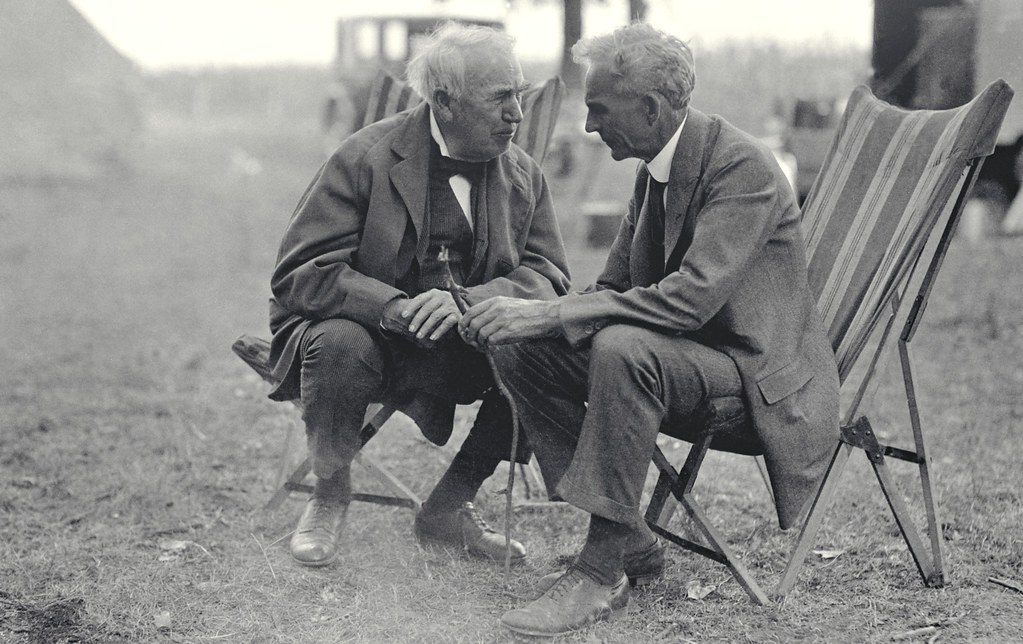
Photo of Thomas Edison and Henry ford courtesy of Ford Motor Company
Recently I spoke with Greg Frenette, the manager of Ford’s Electric Vehicle program and he filled me in on just how long Ford have been working on electric vehicles and vehicle-to-grid technologies. Although not as long as may be indicated in the photo above, Ford’s Advanced Engineering Research group have been working on concepts with respect to plug-in hybrids since 2005.
Ford’s initial utility partners in their plug-in hybrid program were Southern California Edison but they soon expanded the program to include the Electric Power Research Institute (EPRI) as well as a grouping of 10 utilities and research organisations across North America.
This quarter Ford will complete the build-out and deployment to the partner organisations of their fleet of 20 plug-in hybrid Escape’s. These vehicles are demo’ing real world vehicle-to-grid interconnectivity. According to Greg they have
a prototype communication control system on the vehicle which works with a Smart Meter, through the use of wireless Zigbee technology, to give the vehicle owner control and direction in how they access the charge
Part of this limited roll-out is to look closely at the bigger infrastructure issues – what does it mean to introduce EVs onto the grid? What standards will be adopted? What upgrades will be necessary in technology & infrastructure to connect these vehicles both at home and in public to the grid?
Speaking about the integration of the vehicles onto the grid, Greg said:
We can envision how the car will be integrated into the smart home of the future and how the home-owner would have the ability to make trade-offs and decisions that involve the vehicle as well as the energy budget for the rest of the household
It is spectacular to hear that (at least one of) the car manufacturers is thinking about the implications of the rollout of smart grids, realtime pricing tariffs and integrating electric vehicles onto the grid. As I have said before, if a country has a large fleet of electric vehicles, they have the capacity to act as a distributed battery for energy storage at even greater than utility scales. In fact, the Rocky Mountain Institute goes further when they say:
Utilities sell a disproportional amount of their power on hot summer afternoons. At night, business plummets. For the utility, that means their expensive generation and transmission equipment stands idle. “Night-charging” vehicles, therefore, could be a lucrative twist on the business of selling electrons.
The National Renewable Energy Laboratory recently estimated that if half the nation’s light vehicles were ordinary plug-in hybrids they would represent a night-charging market of 230 gigawatts. That’s good news for the U.S. wind industry. In many areas, wind tends to blow harder at night, creating more energy when the vehicles would be charging.
With full vehicle to grid integration those same vehicles could sell back some of their energy to the grid on those hot summer afternoons, when electricity is expensive and potentially prevent the firing up of more expensive and dirty generation.
Even better was that Greg brought up something most others shy away from discussing – the old data ownership question! According to Greg Ford believes that:
The consumer is a key stakeholder when it comes to the data. The communications control capability has to be part of the total value equation to the automotive consumer as well as the energy consumer. Ford is looking for win-win solutions between utility industry, between the auto industry that ultimately provide increased value to both of our customers
Ford wants an open architecture communication solution which has to have “direct consumer applicability, marketability and value to be worthwhile”.
If Ford succeed in rolling out that vision, I’ll be first in line!
Ford are introducing the first fully electric cars to the market in 2010 – 2011 while their first plug-in hybrids will come to market in 2012.
Ford are also looking beyond electric vehicles. They have had a fleet of 30 hydrogen fuel cell vehicles on-road with customers since 2005 with over 1,000,000 miles on them. Ford see electric as a medium term solution to sustainable transport but hydrogen as the longer term goal.
Personally, I’m not convinced about the viability of hydrogen as a solution – especially if IBM can crack the lithium air battery they are working on.
Related articles by Zemanta
- Hydro-Québec and Ford work together to develop electric vehicles (newswire.ca)
- Future Ford Hybrids Will Tell Energy Grid When To Power Up [Cars] (gizmodo.com)
- Ford’s plug-in hybrids will talk to electrical grid (arstechnica.com)
- Ford Testing Car-To-Grid Communications For Plug-in Hybrids (blogs.thecarconnection.com)

